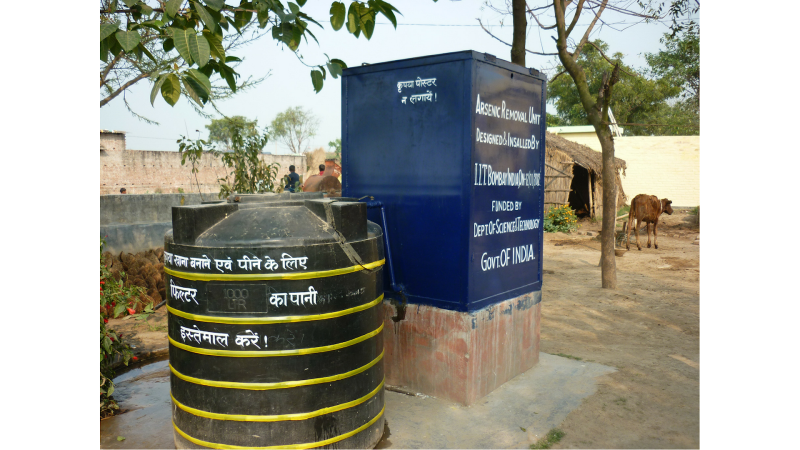
Excess of arsenic in drinking water leads to arsenic poisoning which is linked to cancer, cardiovascular diseases and diabetes in adults and cognitive impairments in unborn babies. Now, researchers from the Indian Institute of Technology Bombay (IIT Bombay) have developed a filter that can reduce arsenic content in drinking water to acceptable levels.
In India, close to 24 crore people living in 21 states have been drinking water containing high levels of arsenic. Among them, the majority live in the Gangetic and Brahmaputra plains, where untreated water from tube wells have notorious levels of this cancer-causing chemical. Developed countries and big cities have a centralised water treatment system to purify water, including arsenic removal. In rural areas of India, settlements are smaller and spread out, and a central water treatment facility is not feasible. On the other hand, decentralised units to purify water are also not useful because they are expensive, inefficient and need skilled labour to operate.
The new arsenic filter, developed by Prof Sanjeev Chaudhari and his team from the Centre for Environmental Science and Engineering at IIT Bombay, can be attached to existing community handpumps, commonly found across India. The filter uses an elemental form of iron present in iron nails to remove arsenic through a chemical reaction between iron, arsenic, and oxygen. The filtering process involves no harmful chemicals and uses up to 20 times lesser amount of iron as compared to other similar techniques.
The researchers claim that the newly developed filters can provide safe drinking water to around 200 families in a village every day and reduce the amount of arsenic by 100 times—sufficient to comply with the recommended international standards. The design of the filter is flexible and can be modified to fit larger filter systems. The arsenic-contaminated waste collected can remain in the filters for about five years without any leak, thus making it safe. They need to be cleaned only once in three months and do not require constant supervision and hence are easy to maintain.
The filters can also be built by local communities, thus saving a considerable cost. “In West Bengal, two local boys were involved in building the filter system, and the local masons and plumbers did the job of installation", says Prof Sanjeev Chaudhari, citing an example. "In Ballia and surrounding areas, one local person, assisted by local masons and plumbers, could do the job”, he adds.
The filter unit needs to be connected to the existing handpumps prevalent in the rural communities by attaching a lift and force unit or by modifying the India Mark II pumps. The filter unit consists of two tanks. Each tank has two sections—one with iron nails and another with stone aggregates. The iron nails convert arsenic into a removable form in the presence of dissolved oxygen present in water and hold on to it. The stone aggregates filter the water and remove other suspended impurities. The two tanks act as a fail-safe mechanism where one still filters the water in case the other fails.
Talking about the cost of installing the new filters, the researchers say that for a community of about 100-200 households, the installation cost ranges from ₹40,000 to ₹75,000 based on the region as the material and transport costs vary. Also, the annual maintenance cost to clean the filter comes up to around ₹1000. Hence, the effective running cost of obtaining arsenic-free water works out to be less than a rupee a month for a family of five!
The researchers first installed arsenic removal filters as a trial in four villages in West Bengal in 2008. On tasting success, they further installed, 60 such filters in the Gangetic plains—27 in Uttar Pradesh, 21 in Bihar, 4 in Assam and 8 in West Bengal. Over time, they have improved the design of the filters to suit the rural masses based on the feedback received from the villagers.
One of the challenges faced in the installation and use of the arsenic filters in the villages is the lack of awareness about such water treatment technologies, say the researchers. The government needs to make efforts to promote such filters in the rural areas. There may be some reluctance too because previous treatment facilities were either too complicated for the villagers to operate, or, in some cases, were very expensive. Although the new filters address these concerns, there are a few technical challenges in the village infrastructure, like the quality of handpumps. “Our arsenic filter seems to be quite robust in delivering good quality water, but the hand pumps have frequent breakdowns due to excessive use, and the filter ends up not being used”, points out Prof Chaudhari.
Another challenge that the researchers point out is that the lack of awareness also affects the maintenance of the filter and the handpump. “Since the arsenic filter was initially provided free of cost, the villagers later did not want to pay for the maintenance of handpump too,” says Prof. Chaudhari. “Wherever people are slightly aware, our arsenic filters are still operational. Hence, the success of the technology will depend on the awareness level and the ability to pay,” he signs off.





